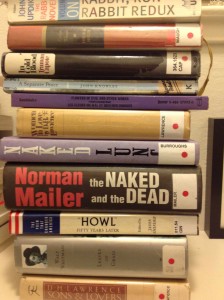Title: Women in Love
Published: 1920
Author: D.H. Lawrence
Challenge status: #75 on Radcliffe Publishing Course Top 100 Novels of the 20th Century, and frequent target of banning attempts (frequently challenged classics) according to the ALA’s Office for Intellectual Freedom. Book #34 on Summer of Banned Books ’13.
Why: A-ha! was seized by John Summers (Sumner??) of the New York Society for the Suppression of Vice and declared obscene (1922). Check out this gig: the Society was chartered by the New York state legislature, allowing the group to search, seize and arrest…and get 50% of all fines levied in resulting cases. Hmmm!!! At least the conflicts of interest are writ large for this group established to police the morality of the public.
First line: ”Ursula and Gudrun Brangwen sat one morning in the window-bay of their father’s house in Beldover, working and talking.”
Synopsis:
Let me just start off by saying that D.H. Lawrence has not just one but THREE novels in the Radcliffe Top 100 and they are ALL on the ALA OIF frequently challenged classics list, as well. I’d read one of them already (Lady Chatterley’s Lover), but, had to read at least one more to fulfill my summer project. Lawrence is a good writer but getting through some of these books is like getting through molasses.
So, Women in Love. Imagine, if you will, a classic Jane Austen set-up. Two nearly spinster (i.e. almost 30 years old) sisters who are frightfully well-bred, a little too educated, a little too proud for their neighborhood. They end up meeting their respective matches and go through a hyper-extended courtship, after which one pair ends up “happily” married and the other pair ends up in a longish-term love affair, not quite as happily. And then something bad happens, which, seems almost fated given the horrible karma associated with love gone bad.












